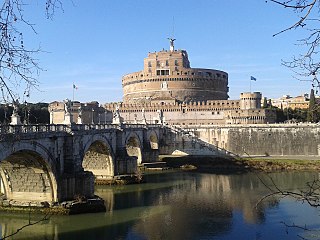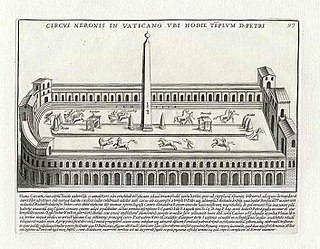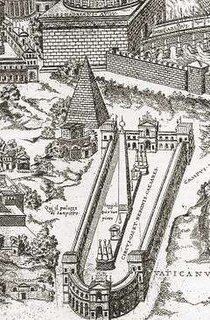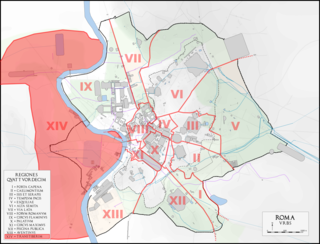
Agrippina "the Elder" was a prominent member of the Julio-Claudian dynasty. She was the daughter of Marcus Vipsanius Agrippa and Augustus' daughter, Julia the Elder. Her brothers Lucius and Gaius Caesar were the adoptive sons of Augustus, and were his heirs until their deaths in AD 2 and 4, respectively. Following their deaths, her second cousin Germanicus was made the adoptive son of Tiberius, Augustus' stepson, as part of Augustus' succession scheme in the adoptions of AD 4. As a result of the adoption, Agrippina was wed to Germanicus in order to bring him closer to the Julian family.

Julia Agrippina, also referred to as Agrippina the Younger, was a Roman empress.

Nero Claudius Caesar Augustus Germanicus was the fifth Roman emperor and the last emperor of the Julio-Claudian dynasty, reigning from AD 54 until his suicide in 68. He was adopted by the Roman emperor Claudius at the age of 13 and succeeded him on the throne. Nero seems to have been popular with the members of his Praetorian Guard, and with lower-class commoners in Rome and the provinces, but was deeply resented by the Roman aristocracy. Most contemporary sources describe him as tyrannical, self-indulgent and debauched. After being declared a public enemy by the Roman Senate, he committed suicide aged 30.

The Mausoleum of Hadrian, usually known as Castel Sant'Angelo, is a towering cylindrical building in Parco Adriano, Rome, Italy. It was initially commissioned by the Roman Emperor Hadrian as a mausoleum for himself and his family. The building was later used by the popes as a fortress and castle, and is now a museum. The structure was once the tallest building in Rome.
Vatican Hill is a hill located across the Tiber river from the traditional seven hills of Rome, that also gave the name of Vatican City. It is the location of St. Peter's Basilica.

The Circus of Nero or Circus of Caligula was a circus in ancient Rome, located mostly in the present-day Vatican City.

Ponte is the 5th rione of Rome, identified by the initials R. V, and is located in Municipio I. Its name comes from Ponte Sant'Angelo, which connects Ponte with the rione of Borgo. This bridge was built by Emperor Hadrian in 134 AD to connect his mausoleum to the rest of the city. Though Pope Sixtus V changed the rione limits, so that the bridge belongs now to Borgo, not to Ponte anymore, the area has kept its name and a bridge as its coat of arms.

Borgo is the 14th rione of Rome, Italy. It is identified by the initials R. XIV and is included within Municipio I.

Ponte Sant'Angelo, originally the Aelian Bridge or Pons Aelius, is a Roman bridge in Rome, Italy, completed in 134 AD by Roman Emperor Hadrian, to span the Tiber from the city centre to his newly constructed mausoleum, now the towering Castel Sant'Angelo. The bridge is faced with travertine marble and spans the Tiber with five arches, three of which are Roman; it was approached by means of a ramp from the river. The bridge is now solely pedestrian and provides a scenic view of Castel Sant'Angelo. It links the rioni of Ponte, and Borgo, to whom the bridge administratively belongs.

The Pons Cestius is an ancient Roman bridge connecting the right bank of the Tiber with the west of the Tiber Island in Rome, Italy. In Late Antiquity, the bridge was replaced and renamed the Pons Gratiani. It is also known as the Italian: Ponte San Bartolomeo, lit. 'Bridge of Saint Bartholomew'. No more than one third of the present stone bridge is of ancient material, as it was entirely rebuilt and extended in the 19th century, after numerous earlier restorations.
Via Cornelia is an ancient Roman road that supposedly ran east–west along the northern wall of the Circus of Nero on land now covered by the southern wall of St. Peter's Basilica. The location is closely associated with the Via Aurelia and the Via Triumphalis.
During the Middle Ages, Rome was divided into a number of administrative regions, usually numbering between twelve and fourteen, which changed over time.

The Temple of Claudius, also variously known as the Temple of the Divus Claudius, the Temple of the Divine Claudius, the Temple of the Deified Claudius, or in an abbreviated form as the Claudium, was an ancient structure that covered a large area of the Caelian Hill in Rome, Italy. It housed the Imperial cult of the Emperor Claudius, who was deified after his death in 54 AD.

Via Trionfale is a Roman road that leads to and within Rome, Italy. Formerly called Via Triumphalis, it was an ancient consular road that connected Rome to Veii. The northern terminus of the road connects with the Via Cassia.

The Meta Romuli was a pyramid built in ancient Rome that is important for historical, religious and architectural reasons. By the 16th century, it was almost completely demolished.

The Terebinth of Nero was a mausoleum built in ancient Rome that is important for historical, religious and architectural reasons. By the 14th century, it was almost completely demolished.

In Ancient Rome, the Ager Vaticanus was the alluvial plain on the right (west) bank of the Tiber. It was also called Ripa Veientana or Ripa Etrusca, indicating the Etruscan dominion during the archaic period. It was located between the Janiculum, the Vatican Hill, and Monte Mario, down to the Aventine Hill and up to the confluence of the Cremera creek.

The Regio IX Circus Flaminius is the ninth regio of imperial Rome, under Augustus's administrative reform. Regio IX took its name from the racecourse located in the southern end of the Campus Martius, close to Tiber Island.

The Regio XIV Transtiberim is the fourteenth regio of imperial Rome, under Augustus's administrative reform. Meaning "across the Tiber", the Regio took its name from its position on the west bank of the Tiber River.




















